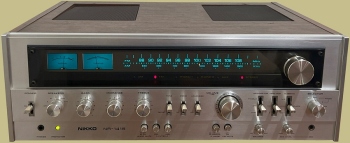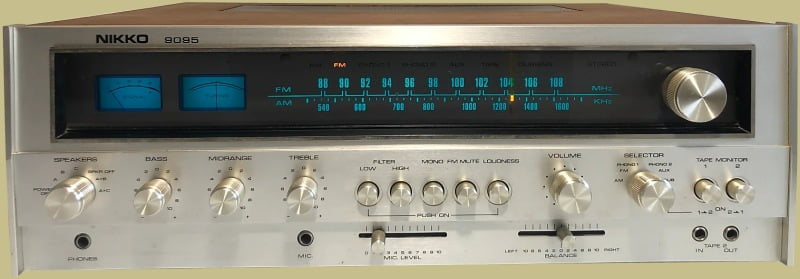
The Nikko 9095 was the top-of-the-line receiver from Nikko in 1976. It retailed for $519.95 and was part of a lineup that included the 2025, 3035, 5055, 6065, 7075, 8085, and 9095. Nikko was not a very well known brand in the U.S. and the receivers are not that common today. The brochure for the 9095 had some interesting wording:
You have just approached an exciting new dimension in stereophonic listening enjoyment; With your purchase of the NIKKO 9095 Stereo Receiver, you have secured a measure of “Daily Happiness” for yourself and your family.
Sounds like an intro to a Twilight Zone episode. It goes on…
NIKKO, translated means ‘‘Daily Happiness” … and translate it does; takes broadcast electronic impulses and translates them into a special brand of music … pleasureful listening for every musical taste.
Maybe the Nikko receiver translates better than the Nikko marketing department.
Nikko equipment of the 1970’s is regarded as well built and a great value in terms of performance and looks. Nikko also made a really good line of separates under the Alpha/Beta/Gamma series name in the very early 1980’s. In the late 80’s they were purchased by ASTI Corp and the build quality went down until they stopped making audio equipment in the 90’s.
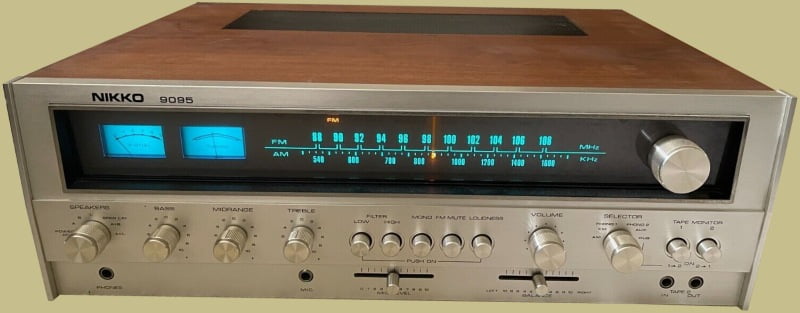
Overall, the Nikko 9095 has some nice styling. The wood case flush with the faceplate is appealing. The blue lit tuning scale and meters along with the Kenwood style tuning needle with lighted tip are nice features as well. The knobs and large push buttons are well laid out. The sliders for balance and mic level are different and the gap between the headphone and mic jacks gives the impression that something is missing. But, in general, it has a nice look to it.
The 9095 has a mid-range tone control which is a nice feature and, as you can see, it has both a basic signal meter and a tuning meter. Only the signal strength meter is illuminated when AM is chosen, while both meters are lit when FM is being tuned in. For other program sources, the meters go dark. The tip of the pointer is illuminated when either AM or FM program sources are selected.
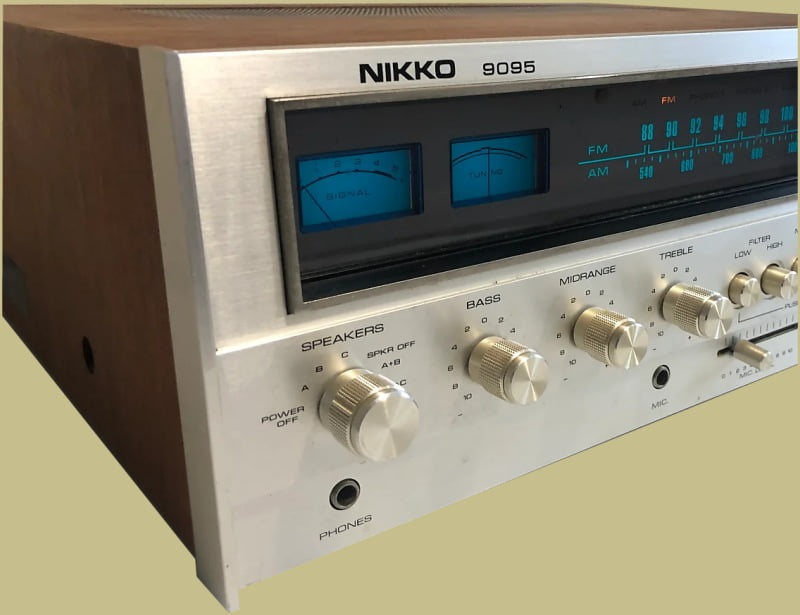
Here are the different models in the lineup with power output, total harmonic distortion and retail price. As you can see the Nikko 9095 produced 63 watts per channel into 8 ohms.
| Model | WPC | THD | Dimensions | Weight | Price |
| 2025 | 10 | 1 | 18 x 5 x 14 | 16 | $199.95 |
| 3035 | 17 | 0.8 | 19 x 6 3/8 x 16 1/8 | 22 | $249.95 |
| 5055 | 22 | 0.8 | 19 x 6 3/8 x 16 1/8 | 22 | $299.95 |
| 6065 | 30 | 0.5 | 19 x 6 3/8 x 16 1/8 | 23 lbs 20 oz | $349.95 |
| 7075 | 38 | 0.5 | 19 x 6 3/8 x 16 1/8 | 25 lbs 6 oz | $399.95 |
| 8085 | 45 | 0.3 | 19 x 6 3/8 x 16 1/8 | 26 | $449.95 |
| 9095 | 63 | 0.3 | 18 15/16 x 6 1/2 x 15 1/4 | 36 lbs 3 oz | $519.95 |
Front Panel
Rotary control knobs along the lower section of the panel include a speaker selector switch, which also turns on power, bass, midrange, and treble tone controls; volume control, and program selector. Pushbuttons in this panel area activate low and high-cut filters, mono/stereo switching, FM muting circuits, loudness circuit, and two tape monitor circuits.
Along the bottom edge of the panel are a headphone jack, tape 2 in and out jacks (duplicating those on the rear panel for front access), and a microphone (mono) input jack. The Mic Level control works independently of the master volume control and therefore permits mic mixing with any of the other available program sources. A center-detented slide control is used for left-right channel balance.

FM Tuner
Neither the FM nor the AM frequency scales are linearly calibrated. This isn’t a big deal but can result in the needle being slightly off the number on the dial at full signal strength. Here is what Audio magazine said about the 9095’s FM tuner:
In listening to the FM performance of the Nikko 9095, we were at once aware of what, to us, seemed like slightly overemphasized highs. Checking frequency response, we discovered that the de-emphasis was a bit off and that at 15 kHz (where most receivers actually roll off more than the prescribed amount -17.07 dB), de -emphasis resulted in a roll – off of only 13 dB. In other words, at 15 kHz there was about 4 dB of net treble boost. One downward click of the treble control (which has detented or click -stop positions) corrected this flaw and things sounded fine. Sensitivity was excellent, and there was no trouble from alternate channel interference at any point on the FM tuning dial. Muting threshold was a bit on the high side (we had measured it at 14 µV/28.1 dBf), which meant that we had to forego the luxury of interstation noise muting to pick up those really weak signals we use to check product sensitivity, in a practical way, at our listening location. On the other hand, since muting is set at just about the same point as stereo switching, one can almost use the muting feature as a means of insuring that those stereo stations which manage to overcome the muting threshold will also be heard in full stereo without having to worry about stereo switching sensitivity.
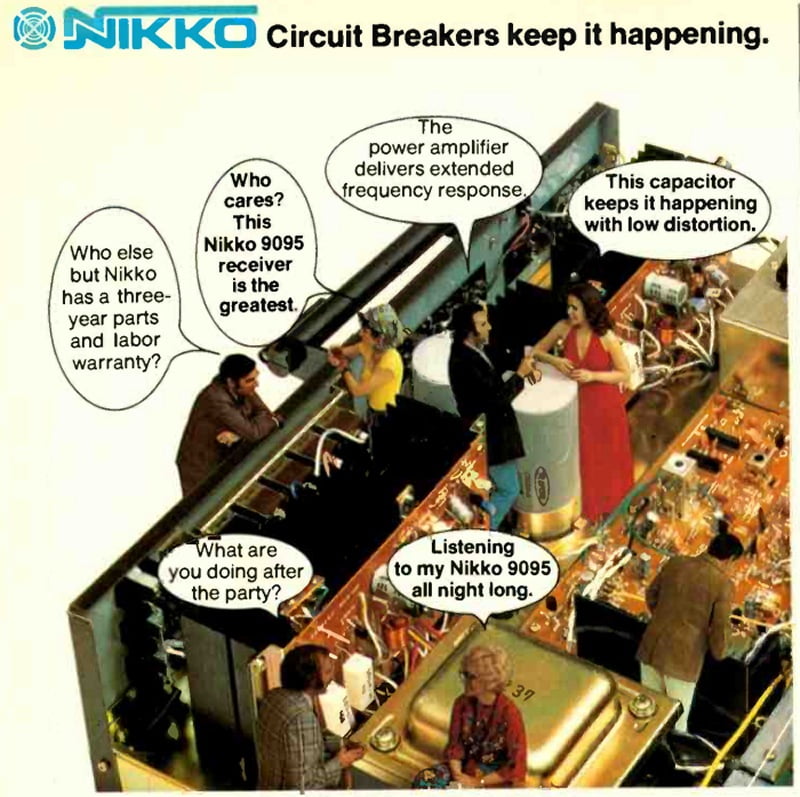
Nikko Circuit Breaker System
Nikko used a unique circuit breaker system instead of fuses for circuitry protection. If the unit shuts down, you push a reset button to get it going again. This approach may be related to the fact the Nikko was mainly producing industrial circuit breakers before they began manufacturing audio equipment.
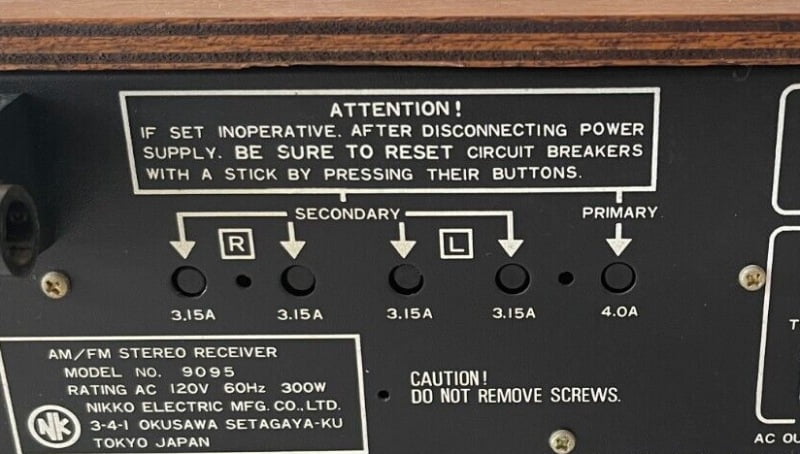
The inside of the Nikko 9095 is laid out very nicely and is a pretty easy receiver to work on. The entire tuner section, including multiplex circuitry, is contained on the largest of several P.C. boards, with the shielded r.f. front-end mounted directly to that major assembly. Two identical power amplifier modules are integrally tied to heat sink assemblies near the rear of the unit.

Rear Panel
The rear panel of the 9095 features three sets of speaker push-terminals. Preamp-out and main amp-in jacks are internally interconnected (or disconnected) by means of an adjacent slide switch. The jack labelled “composite output” was intended for use with 4-channel FM adaptors which aren’t used today.
The five circuit-breaker re-set buttons eliminate the need for replaceable line and power supply fuses. Even though the program selector shows only one Aux position, there are two sets of Aux input jacks, each having a different input sensitivity (180 mV and 350 mV). You can choose one set (but not both) to match loudness levels of other internal sources or the phono levels when connecting a program source to Aux. Two turntables can be used with the receiver. In addition to the tape-in and tape-out jacks, there is a familiar DIN multiple pin socket to take care of decks equipped with that type of connector. One switched and two un-switched AC receptacles, a chassis ground terminal, and an AM ferrite bar antenna.

The 1970’s and very early 80’s Nikko audio equipment is generally undervalued given the quality and performance they provide. They are very well built, look great and are usually reasonably priced. If you see one in good working condition don’t be shy – check it out.

